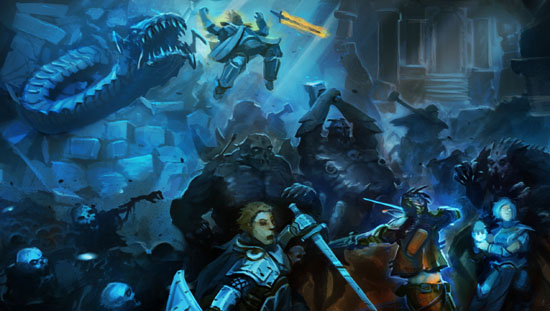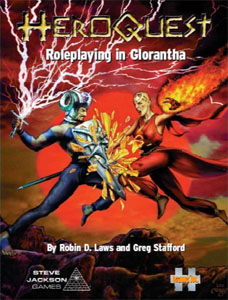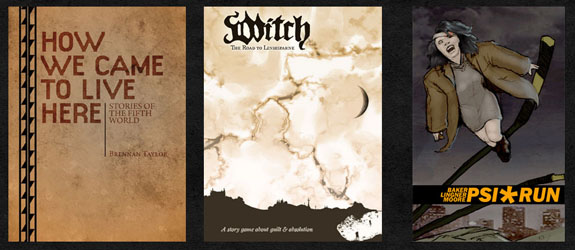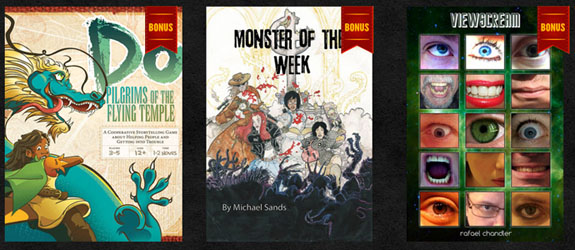Tagline: A simple vehicle construction system. An oxymoron? Not so. Big Robots, Cool Starships succeeds at the impossible.
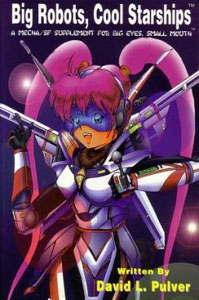 Big Robots, Cool Starships, the first supplement for the Big Eyes, Small Mouth roleplaying game, is perhaps the most surprising gaming product I have read all year.
Big Robots, Cool Starships, the first supplement for the Big Eyes, Small Mouth roleplaying game, is perhaps the most surprising gaming product I have read all year.
Did I say surprising? I meant mind-blowing… as in “mind-blowingly good”.
Why is it surprising? you ask. (We’ll get to “mind-blowing” later.) Very simple: This book should not be anywhere near as good as it is.
First off, it is a vehicle construction system for a simple game. And when I say “vehicle construction system” I mean “vehicle construction system”. BRCS doesn’t cut corners and it doesn’t fudge (any more than BESM does). It is a concrete, dynamic, flexible system with precise definitions and seemingly limitless potential. This type of thing should not exist. And yet it does. BRCS not only succeeds at being a true system, it also manages to pull it off without becoming far too complex for the basic game. We’ll get back to how this is all possible in a couple seconds.
Second, BRCS is written by David L. Pulver. I also discovered (by reading Mark C. MacKinnon’s Foreward to the book) that Pulver signed on as Associate Line Editor and Senior Staff Writer for Guardians of Order back in November of ’98. This would, of course, be the same acclaimed David L. Pulver who wrote GURPS Biotech, GURPS Mecha, GURPS Vehicles, and the forthcoming revision of GURPS Space. It isn’t surprising, therefore, that Pulver can turn out products of sterling quality. What is surprising is that Pulver is working on BESM. I can’t imagine a longer, or stranger, jump than the one taken from GURPS to Big Eyes, Small Mouth. What is even more surprising is that Pulver, one of the Founding Fathers of vehicle construction systems in my mind, could have turned out BRCS — which is unlike any VCS I’ve seen before.
Then again, maybe that isn’t so surprising either.
By this point I’ve either tantalized or bored you enough. What the heck is this Big Robots, Cool Starships thing, anyway?
THE SYSTEM
Big Robots, Cool Starships is – in its own words – “a mecha/SF supplement for Big Eyes, Small Mouth”. It expands the basic BESM system to allow for more dynamic mecha play – “mecha” being used in its more broad-based definition of “any mechanical device found in anime”. To sum up, therefore, BRCS is a vehicle construction system (plus some general campaign info) for big robots, combat cyborgs, really cool cars, cybernetic body armor, starships, fighters, tanks, and just about anything else you can think of with two gears to rub together.
Note the word “expand”, above. It’s there for a very good reason. When most games have a book described with the blurb “new rules for XXX!” what that really means is “the system in the core rulebook for XXX was so crappy that we’ve completely ripped it out and are starting over from scratch; plus we’re charging you extra for the privilege of having decent rules”.
BRCS isn’t like that at all. The system for “giant robots” and their ilk in the core BESM rulebook works just fine. BRCS is, literally, an expansion of that basic system. It doesn’t replace; it adds to.
“But wait,” you say, “If the basic system works just fine, why does it need expanding?” The answer is simple: It doesn’t need expanding. But some people might want it expanded. If you’re running mecha-oriented campaigns, then the rules in BRCS will provide you with more options, more detail, and more innate potential. Think of it like this: In first grade you learned about addition. It wasn’t until later on that they taught you multiplication. Was the system you had learned for addition incomplete because now you had this new thing called “multiplication”? Of course not. Multiplication was simply an expansion of your mathematical concepts – more useful for some things; less useful for others. Same thing applies here.
BRCS accomplishes this expansion in a five-step process: First it redefines the “Own a Big Robot” attribute from the basic BESM rulebook to include all sorts of mecha. (“Ah ha! They did change something!” Oh, calm down. Would you have preferred it if they added a whole new attribute which accomplished nothing at all? Sheesh.). Second, they made it so that both “Own a Big Robot” and “Cybernetic Body” give you a pool of “Mecha Points”. Third, they added the attribute “More Powerful Robot” to get you some additional Mecha Points. Fourth, they added the “Personal Gear” attribute to cover situations where a character has access to gear your average person probably wouldn’t (okay, this isn’t really all that important, but I wanted a “five-step” process not a “four-step” process — so sue me). Finally, they inserted a six-step mecha design process between Step Five and Step Six of character creation as described in BESM. These steps are conveniently numbered 5A through 5F.
Basic character creation in BESM is an eight-step process. Half of those had nothing to do with the system at all (they were entirely conceptual). Similarly, three of the six steps to mecha design as described in BRCS are conceptual in nature, not mechanical – Step 5A is “GM Discussion” (self-explanatory); Step 5B is “Mecha Outline” (get your concept); and Step 5F is “Mecha Background” (when all the numbers are hashed out, your write up the details to “personalize your creation”). Therefore it’s steps 5C, 5D, and 5E which are the meat of this system. Let’s take a closer look.
Step 5C: Mecha Sub-Attributes. The BRCS system for mecha creation is extremely similar to the basic BESM character creation system. Not only is BRCS an expansion to the BESM rules, it is a seamless one – the system naturally fits right into the existing character creation process, as if it had always been meant to be there. To avoid not only the “let’s replace everything” syndrome, but also the “tacked on rules” syndrome is, quite frankly, amazing (have I used that word and its synonyms often enough to make this review’s conclusion clear, yet?).
Character creation in BESM starts with the purchasing of Attributes (with five discrete levels). BRCS mecha creation starts with the purchasing of Sub-Attributes (with six discrete levels). These are things like “Super Strength”, “Space Flight”, “Artificial Intelligence”, and so on. Like BESM character creation, BRCS is very much an open-ended effects-based system – you purchase “Space Flight” in order to build intergalactic battlecruisers and 20th century spacesuits alike. The system is incredibly dynamic and resilient, although it tends to scale poorly: You can build BMW’s and intergalactic cruisers; but you can’t have them face off against each other very well. This isn’t a major issue, and can easily be worked around in the rare circumstance when it actually crops up (for example, by giving the intergalactic cruiser appropriate action resolution bonuses based on its size, etc.; or you could just GM fiat the situation out of the way, the necessary difference between the technology levels before the problem crops up being large enough that there is really only one logical conclusion in most of these situations).
Step 5D: Mecha Defects. The next step in BESM character creation is the selection of Defects – which give you Bonus Points to spend on additional Attributes. Similarly, Mecha Defects (“Exposed Occupants”, “Hanger Queen”, “Start-Up Time”) give you additional points to spend on Mecha Sub-Attributes.
Between purchasing additional levels of “Own a Big Robot” or “Cybernetic Body” (which give you big chunks of extra Mecha Points); purchasing “More Powerful Robot” (for smaller chunks of extra Mecha Points); and Mecha Defects (for very small, precise chunks of extra Mecha Points) you should be able to tweak things for your character in just the right way so that there is little or no slop in the number of Mecha Points you purchased versus the number of Mecha Points you need to build your mecha.
Step 5E: Mecha Derived Values. Finally you figure out the mecha’s “Armour”, “Health Points”, “Energy Points”, and “Combat Value” based on its attributes. Action resolution proceeds normally.
As I said with character creation in BESM: It don’t get much easier than this.
OTHER STUFF
So Big Robots, Cool Starships is a vehicle construction system, focusing on mecha. Right? Right.
But wait… there’s more! The book also contains:
1. A brief, two page overview of the history of mecha in Japanese anime. It is surprisingly detailed considering its short length (particularly considering the broad definition of “mecha” with which the supplement is working). Noticeable oversights (at least to me) included Bubblegum Crisis and Armored Trooper Votoms. Plus, Pulver tends to ignore manga entirely (even when the series he is talking about was manga before it was anime). I was also upset that he referred to Robotech as the English translation for Super Dimensional Fortress Macross — if you don’t have the space to detail the controversy regarding the relationship between those two pieces of animation, then please don’t mention them at all.
2. A chapter on “Mecha Combat and Other Actions”. You might be thinking “new rules”, but you’d be wrong. With the exception of a couple of charts on “Falling Damage” and “Crash Damage”, health points for buildings, and a list of suggested mecha-related resolution modifiers the section is pretty much ruleless. This is for the best: The basic BESM resolution mechanics are more than capable of handling mecha. This is a testament not only to the strength of BESM’s mechanics, but also the strength of Pulver’s design system (insofar as it remains completely compatible). So what is in this section? Guidelines. Stuff you might not think of, but which Pulver takes the time to mention and bring to your attention. Excellent stuff. With a system like BESM I don’t need a rule for every occasion, and by simply bringing the stuff to my attention Pulver has done more than enough. Kudos for this restraint, which leads to a far better product than if these twenty pages had been packed full of useless rules (which would have ruined the simple elegance of BESM).
3. And we’re still not done. Pulver includes a short section on potential mecha campaign settings (from Ancient Japan to High Fantasy to Modern Day to Far Future); a game seed for each of those campaign settings; and a sample adventure.
4. Finally, I just want to make note that with this product Guardians of Order has moved up my list from “company which produces interesting stuff” to “company whose stuff you should buy”. The minor quibbles I had with their production values in their first publication (the core BESM rules) have evaporated; their general art quality has improved tremendously (although I’m still spoiled by the folks over at Dream Pod 9, so I’ll say they could be even better); their writing remains spotless (particularly with Pulver at the helm); their product conception is elegant; and their future plans look bright (with Dominion Tank Police and Demon City Shinjuku RPGs in the future as well as additional supplements for BESM).
5. To end on a weird note: BRCS has a two-page index with an entry for just about every major concept in the book. This is great, right? Wrong. Every single entry has exactly one (and only one) referenced page number. According to this index, for example, “Big Eyes, Small Mouth” is referenced only once: On page six. Not only is this, of course, inaccurate, it’s actually mentioned on page five and page seven as well. This is completely bizarre. Out of curiosity I went back and checked the core BESM manual. It’s the same damn thing! I don’t get it. This is not how indexes work!
CONCLUSION
Big Robots, Cool Starships is, in my estimation, one of the best supplements of its type I have ever read. I’ve never seen a rules-based supplement mesh so seamlessly and effortlessly with its mother product. BRCS doesn’t leave you feeling as if you were ripped off by the mecha rules in BESM; yet at the same time once you own it you know you wouldn’t want to play without it. On top of it all, Pulver has thrown in campaign seeds and a fairly interesting adventure.
When I need a simple system which is, nonetheless, a solid game engine (so that I don’t have to fudge a lot of different things to make it work) BESM has become the game I look to. BESM is the best game of its type I have encountered. The same holds true, now, for BRCS — even if I’m not sure there is another product like BRCS out there.
In short, Big Robots, Cool Starships is not only an excellent product, it is a solid product. You won’t be disappointed.
Style: 4
Substance: 5
Author: David L. Pulver
Company/Publisher: Guardians of Order
Cost: $15.95
Page count: 110
ISBN: 0-9682431-3-4
Originally Posted: 1999/08/06
As I mentioned in my review of Big Eyes, Small Mouth, the second edition of the game remains a go-to system for me. And BRCS remains one of the best vehicle construction systems I’ve ever used (although it has been awhile since I had cause to actually pull it out and play around with it).
For an explanation of where these reviews came from and why you can no longer find them at RPGNet, click here.

